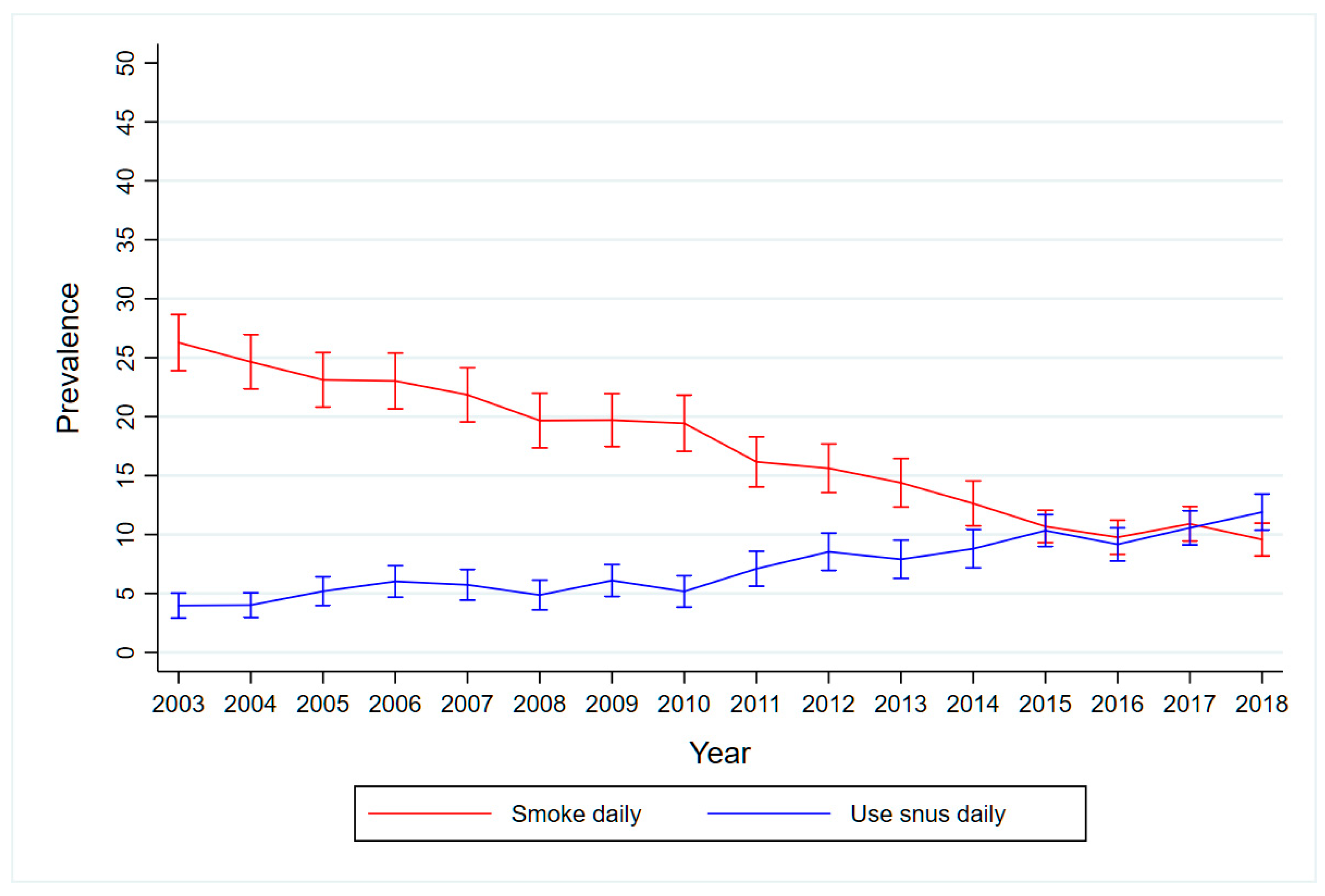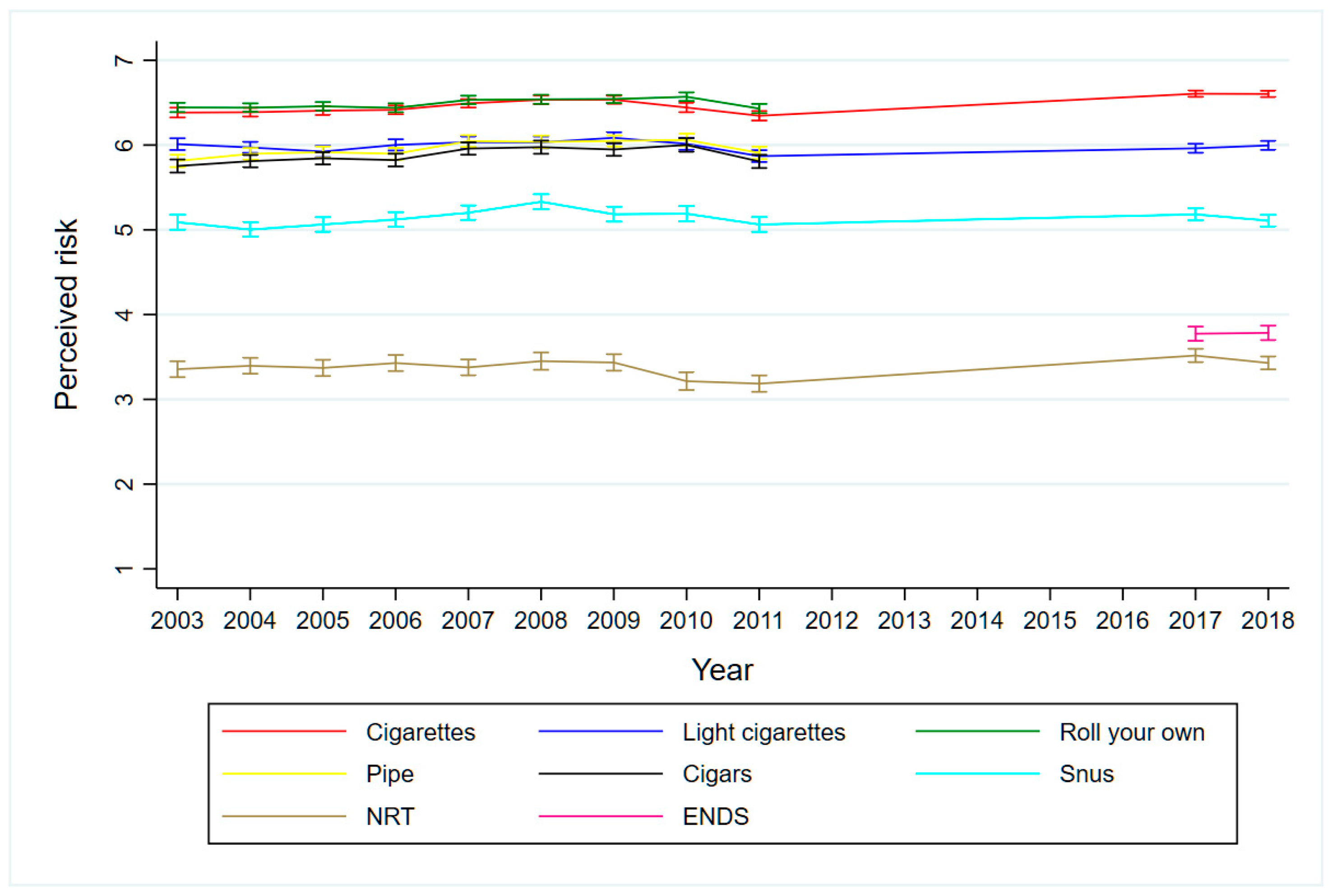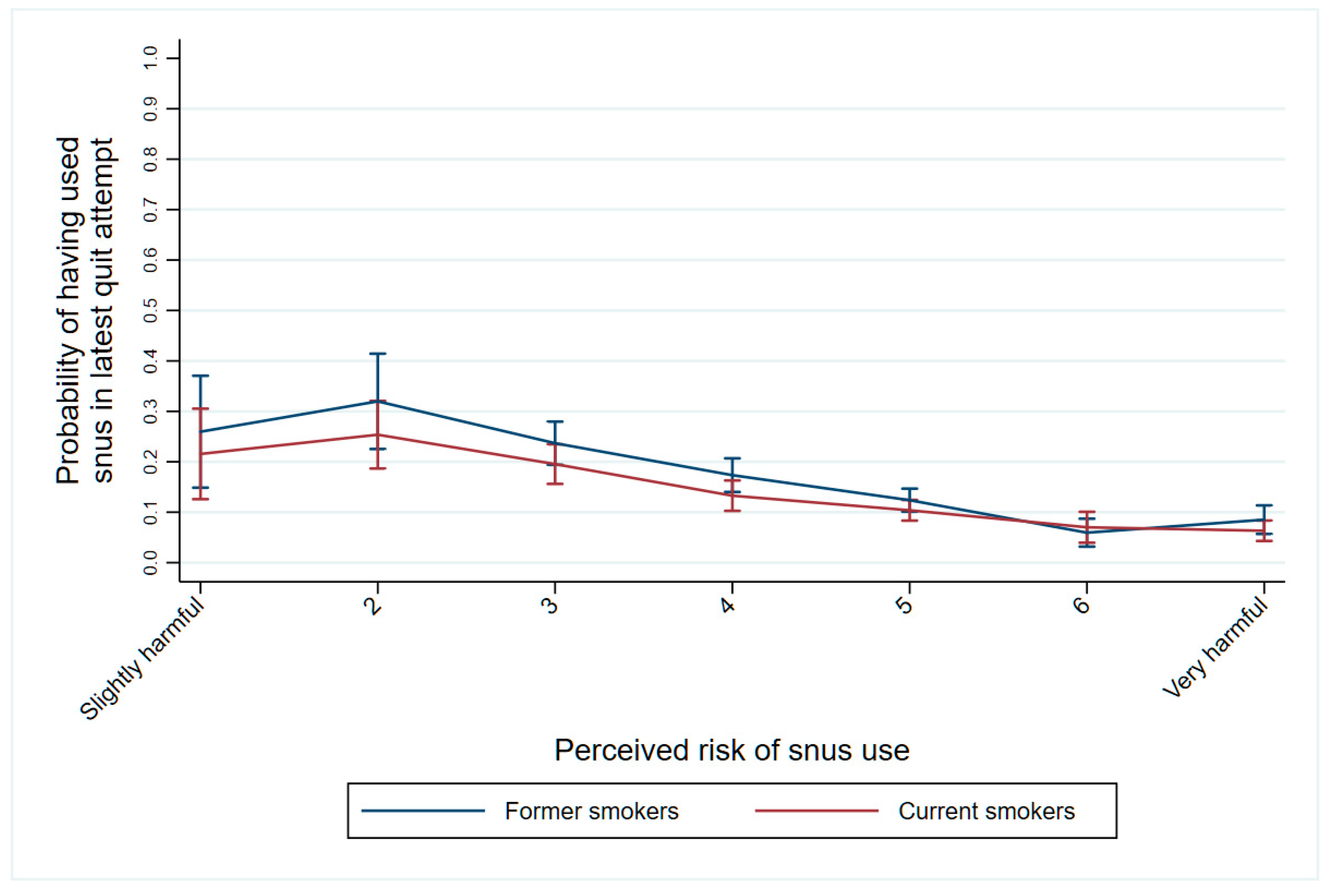Relative Risk Perceptions between Snus and Cigarettes in a Snus-Prevalent Society—An Observational Study over a 16 Year Period
Abstract
1. Background
Aims
2. Methods
2.1. Material
2.2. Measures
2.3. Current Use of Products
2.4. Socio-Demographic Information
3. Analysis
3.1. Aim 1: Risk Perceptions of Nicotine Products and Changes Over Time
3.2. Aim 2: Association of Snus Risk Overestimation with Respondent Characteristics
3.3. Aim 3: Relation between Perceived Harmfulness of Snus and the Likelihood of Using Snus in Quit-Smoking Attempts
4. Results
5. Discussion
5.1. Snus vs E-Cigarettes
5.2. Risk-Use Equilibrium
5.3. Confirmation and Optimism Bias
5.4. Limitations
5.5. Strengths
5.6. Implications
5.7. Future Research
6. Conclusions
Author Contributions
Funding
Conflicts of Interest
Abbreviations
| AIC | Akaike information criterion |
| BIC | Bayesian information criterion |
| CI | confidence interval |
| ENDS | electronic delivery systems |
| NRT | nicotine replacement therapy |
| PAH | polycyclic hydrocarbons |
| RRP | relative risk perceptions |
| SD | standard deviation |
| SLT | smokeless tobacco |
| TSNA | tobacco specific nitrosamines |
| US | United States |
| WHO | World Health Organization |
References
- Glanz, K.; Rimer, B.K.; Viswanath, K. (Eds.) Health Behavior and Health Education: Theory, Research, and Practice, 4th ed.; Jossey-Bass: San Francisco, CA, USA, 2008. [Google Scholar]
- Janz, N.K.; Becker, M.H. The Health Belief Model: A decade later. Health Educ. Q. 1984, 11, 1–47. [Google Scholar] [CrossRef] [PubMed]
- Weinstein, N.D. The precaution adoption process. Health Psychol. 1988, 7, 355–386. [Google Scholar] [CrossRef] [PubMed]
- Gerking, S.; Khaddaria, R. Perceptions of health risk and smoking decisions of young people. Health Econ. 2012, 21, 865–877. [Google Scholar] [CrossRef] [PubMed]
- Song, A.V.; Morrell, H.E.; Cornell, J.L.; Ramos, M.E.; Biehl, M.; Kropp, R.Y.; Halpern-Felsher, B.L. Perceptions of smoking-related risks and benefits as predictors of adolescent smoking initiation. Am. J. Public Health 2009, 99, 487–492. [Google Scholar] [CrossRef] [PubMed]
- Borrelli, B.; Hayes, R.B.; Dunsiger, S.; Fava, J.L. Risk perception and smoking behavior in medically ill smokers: A prospective study. Addiction 2010, 105, 1100–1108. [Google Scholar] [CrossRef] [PubMed]
- Costello, M.J.; Logel, C.; Fong, G.T.; Zanna, M.P.; McDonald, P.W. Perceived risk and quitting behaviors: Results from the ITC 4-country survey. Am. J. Health Behav. 2012, 36, 681–692. [Google Scholar] [CrossRef] [PubMed]
- Jacobson, J.D.; Catley, D.; Lee, H.S.; Harrar, S.W.; Harris, K.J. Health risk perceptions predict smoking-related outcomes in Greek college students. Psychol. Addict. Behav. 2014, 28, 743–751. [Google Scholar] [CrossRef] [PubMed]
- Fiore, M.; Jaen, C.; Baker, T.; Bailey, W.; Benowitz, N.; Curry, S.; Dorfman, S.F.; Froelicher, E.S.; Goldstein, M.G.; Healton, C.G.; et al. Treating Tobacco Use and Dependence: 2008 Update; U.S. Department of Health and Human Services, Public Health Service: Rockville, MD, USA, 2008.
- Tomar, S.L.; Hatsukami, D.K. Perceived risk of harm from cigarettes or smokeless tobacco among US high school seniors. Nicotine Tob. Res. 2007, 9, 1191–1196. [Google Scholar] [CrossRef] [PubMed]
- Kaufman, A.R.; Persoskie, A.; Twesten, J.; Bromberg, J. A review of risk perception measurement in tobacco control research. Tob. Control 2018. [CrossRef] [PubMed]
- Czoli, C.D.; Fong, G.T.; Mays, D.; Hammond, D. How do consumers perceive differences in risk across nicotine products? A review of relative risk perceptions across smokeless tobacco, e-cigarettes, nicotine replacement therapy and combustible cigarettes. Tob. Control 2017, 26, e49–e58. [Google Scholar] [CrossRef] [PubMed]
- Fong, G.T.; Elton-Marshall, T.; Driezen, P.; Kaufman, A.R.; Cummings, K.M.; Choi, K.; Kwan, J.; Koblitz, A.; Hyland, A.; Bansal-Travers, M.; et al. U.S. adult perceptions of the harmfulness of tobacco products: Descriptive findings from the 2013–14 baseline wave 1 of the path study. Addict. Behav. 2018, 91, 180–187. [Google Scholar] [CrossRef] [PubMed]
- Royal College of Physicians. Harm Reduction in Nicotine Addiction Helping People Who Can’t Quit; A Report by the Tobacco Advisory Group of the Royal College of Physicians; RCP: London, UK, 2007. [Google Scholar]
- Scientific Committee on Emerging and Newly-Identified Health Risks (SCENHIR). Scientific Opinion on the Health Effects of Smokeless Tobacco Products; European Commission: Brussels, Belgium, 2008. [Google Scholar]
- Rostron, B.L.; Chang, J.T.; Anic, G.M.; Tanwar, M.; Chang, C.M.; Corey, C.G. Smokeless tobacco use and circulatory disease risk: A systematic review and meta-analysis. Open Heart 2018, 5, e000846. [Google Scholar] [CrossRef] [PubMed]
- WHO Study Group on Tobacco Production Regulation. WHO Study Group on Tobacco Product Regulation. Report on the Scientific Basis of Tobacco Product Regulation: Third Report of a WHO Study Group; World Health Organization: Geneva, Switzerland, 2009. [Google Scholar]
- Kaufman, A.R.; Mays, D.; Koblitz, A.R.; Portnoy, D.B. Judgments, awareness, and the use of snus among adults in the United States. Nicotine Tob. Res. 2014, 16, 1404–1408. [Google Scholar] [CrossRef] [PubMed]
- Biener, L.; Roman, A.M.; Mc Inerney, S.A.; Bolcic-Jankovic, D.; Hatsukami, D.K.; Loukas, A.; O’Connor, R.J.; Romito, L. Snus use and rejection in the USA. Tob. Control 2014, 25, 386–392. [Google Scholar] [CrossRef] [PubMed]
- Sæbø, G.; Tokle, R. Norske Avisers Dekning av snus 2002–2011—En Innholdsanalyse (Norwegian Newspaper Coverage of Snus 2002–2011—A Content Analysis); Norwegian Institute for Alcohol and Drug Research: Oslo, Norway, 2014. [Google Scholar]
- Wilson, S.; Partos, T.; McNeill, A.; Brose, L.S. Harm perceptions of e-cigarettes and other nicotine products in a UK sample. Addiction 2019. [Google Scholar] [CrossRef] [PubMed]
- Wackowski, O.A.; Bover Manderski, M.T.; Delnevo, C.D. Comparison of Direct and Indirect Measures of E-cigarette Risk Perceptions. Tob. Regul. Sci. 2016, 2, 38–43. [Google Scholar] [CrossRef] [PubMed]
- Peiper, N.; Stone, R.; Van Zyl, R.; Rodu, B. University faculty perceptions of the health risks related to cigarettes and smokeless tobacco. Drug Alcohol Rev. 2010, 29, 121–130. [Google Scholar] [CrossRef] [PubMed]
- Popova, L.; Ling, P.M. Perceptions of relative risk of snus and cigarettes among US smokers. Am. J. Public Health 2013, 103, e21–e23. [Google Scholar] [CrossRef] [PubMed]
- Persoskie, A.; Nguyen, A.B.; Kaufman, A.R.; Tworek, C. Criterion validity of measures of perceived relative harm of e-cigarettes and smokeless tobacco compared to cigarettes. Addict. Behav. 2017, 67, 100–105. [Google Scholar] [CrossRef] [PubMed]
- Lund, M.; Lund, K.E.; Kvaavik, E. Hardcore smokers in Norway 1996–2009. Nicotine Tob. Res. 2011, 13, 1132–1139. [Google Scholar] [CrossRef] [PubMed]
- Nutt, D.J.; Phillips, L.D.; Balfour, D.; Curran, H.V.; Dockrell, M.; Foulds, J. Estimating the harms of nicotine-containing products using the MCDA approach. Eur. Addict. Res. 2014, 20, 218–225. [Google Scholar] [CrossRef] [PubMed]
- Levy, D.T.; Mumford, E.A.; Cummings, K.M.; Gilpin, E.A.; Giovino, G.; Hyland, A.; Sweanor, D.; Warner, K.E. The Relative Risks of a Low-Nitrosamine Smokeless Tobacco Product Compared with Smoking Cigarettes: Estimates of a Panel of Experts. Cancer Epidemiol. Biomark. Prev. 2004, 13, 2035–2042. [Google Scholar]
- Savitz, D.A.; Meyer, R.E.; Tanzer, J.M.; Mirvish, S.S.; Lewin, F. Public health implications of smokeless tobacco use as a harm reduction strategy. Am. J. Public Health 2006, 96, 1934–1939. [Google Scholar] [CrossRef] [PubMed]
- Lee, P.N. Epidemiological evidence relating snus to health—An updated review based on recent publications. Harm Reduct. J. 2013, 10, 36. [Google Scholar] [CrossRef] [PubMed]
- Wiium, N.; Aarø, L.E.; Hetland, J. Subjective attractiveness and perceived trendiness in smoking and snus use: A study among young Norwegians. Health Educ. Res. 2009, 24, 162–172. [Google Scholar] [CrossRef] [PubMed]
- Lund, M.; Lund, K.E.; Halkjelsvik, T. Contrasting Smokers’ and Snus Users’ Perceptions of Personal Tobacco Behavior in Norway. Nicotine Tob. Res. 2014, 16, 1577–1585. [Google Scholar] [CrossRef] [PubMed]
- Lund, M.; Vedøy, T.F. Røykeslutt (Smoking Cessation). Norwegian Institute of Public Health, 2018. Available online: https://www.fhi.no/nettpub/tobakkinorge/bruk-av-tobakk/roykeslutt (accessed on 29 October 2018).
- Lund, K.E. Tobacco harm reduction in the real world: Has the availability of snus in Norway increased smoking cessation? Drugs Alcohol Today 2013, 13, 92–101. [Google Scholar] [CrossRef]
- Lund, K.E. Association between willingness to use snus to quit smoking and perception of relative risk between snus and cigarettes. Nicotine Tob. Res. 2012, 14, 1221–1228. [Google Scholar] [CrossRef] [PubMed]
- Lund, K.E.; McNeill, A.; Scheffels, J. The use of snus for quitting smoking compared with medicinal products. Nicotine Tob. Res. 2010, 12, 817–822. [Google Scholar] [CrossRef] [PubMed]
- Lund, K.E.; Scheffels, J.; McNeill, A. The association between use of snus and quit rates for smoking: Results from seven Norwegian cross-sectional studies. Addiction 2010, 106, 162–167. [Google Scholar] [CrossRef] [PubMed]
- Scheffels, J.; Lund, K.E.; Mcneill, A. Contrasting snus and NRT as smoking cessation methods. An observational study. Harm Reduct. J. 2012, 9, 10. [Google Scholar] [CrossRef] [PubMed]
- Vedøy, T.F.; Lund, K.E. Utbredelse av snus i Norge (Use of snus in Norway). Norwegian Institute of Public Health, 2018. Available online: https://www.fhi.no/nettpub/tobakkinorge/bruk-av-tobakk/utbredelse-av-snus-i-norge (accessed on 29 October 2018).
- Tokle, R.; Vedøy, T.F.; Lund, K.E. Utbredelse av E-Sigaretter og Fordampere i Norge (Use of E-Cigarettes and Vaporizers in Norway). Norwegian Institute of Public Health, 2018. Available online: https://www.fhi.no/nettpub/tobakkinorge/bruk-av-tobakk/utbredelse-av-e-sigaretter-og-fordampere-i-norge (accessed on 29 October 2018).
- Kozlowski, L.T.; Strasser, A.A.; Giovino, G.A.; Erickson, P.A.; Terza, J.V. Applying the risk/use equilibrium: Use medicinal nicotine now for harm reduction. Tob. Control 2001, 10, 201–203. [Google Scholar] [CrossRef] [PubMed]
- Gartner, C.E.; Hall, W.D.; Vos, T.; Bertram, M.Y.; Wallace, A.L.; Lim, S.S. Assessment of Swedish snus for tobacco harm reduction: An epidemiological modelling study. Lancet 2007, 369, 2010–2014. [Google Scholar] [CrossRef]
- Lund, K.E.; Vedøy, T.F.; Bauld, L. Do never smokers make up an increasing share of snus users as cigarette smoking declines? Changes in smoking status among male snus users in Norway 2003–2015. Addiction 2016, 112, 340–348. [Google Scholar] [CrossRef] [PubMed]
- Borland, R.; Cooper, J.; McNeill, A.; O’Connor, R.; Cummings, K.M. Trends in beliefs about the harmfulness and use of stop-smoking medications and smokeless tobacco products among cigarettes smokers: Findings from the ITC four-country survey. Harm Reduct. J. 2011, 8, 21. [Google Scholar] [CrossRef] [PubMed]
- Minaker, L.M.; Shuh, A.; Burkhalter, R.J.; Manske, S.R. Hookah use prevalence, predictors, and perceptions among Canadian youth: Findings from the 2012/2013 Youth Smoking Survey. Cancer Causes Control 2015, 26, 831–838. [Google Scholar] [CrossRef] [PubMed]
- Richardson, A.; Pearson, J.; Xiao, H.; Stalgaitis, C.; Vallone, D. Prevalence, harm perceptions, and reasons for using noncombustible tobacco products among current and former smokers. Am. J. Public Health 2014, 104, 1437–1444. [Google Scholar] [CrossRef] [PubMed]
- Hart, W.; Albarracin, D.; Eagly, A.H.; Brechan, I.; Lindberg, M.J.; Merrill, L. Feeling validated versus being correct: A meta-analysis of selective exposure to information. Psychol. Bull. 2009, 135, 555–588. [Google Scholar] [CrossRef] [PubMed]
- Masiero, M.; Lucchiari, C.; Pravettoni, G. Personal Fable: Optimistic Bias in Cigarette Smokers. Int. J. High Risk Behav. Addict. 2015, 4, e20939. [Google Scholar] [CrossRef] [PubMed]
- Institute of Medicine of the National Academies. Methods for Studying Risk Perception and Risk Communication. Scientific Standards for Studies on Modified Risk Tobacco Products; The National Academies Press: Washington, DC, USA, 2012. [Google Scholar]
- Lund, I.; Scheffels, J. Perceptions of relative risk of disease and addiction from cigarettes and snus. Psychol. Addict. Behav. 2014, 28, 367–375. [Google Scholar] [CrossRef] [PubMed]
- Weinstein, N.D. Smokers’ recognition of their vulnerability to harm. In Smoking—Risk, Perception, & Policy; Slovic, P., Ed.; Sage Publications: Thousand Oaks, CA, USA, 2001; pp. 81–96. [Google Scholar]
- Weinstein, N.D. What does it mean to understand a risk? Evaluating risk comprehension. JNCI Monogr. 1999, 25, 15–20. [Google Scholar] [CrossRef]
- World Health Organization. WHO Report on the Global Tobacco Epidemic 2011. Warning about the Dangers of Tobacco; World Health Organization: Geneva, Switzerland, 2011. [Google Scholar]
- MacGregor, D.G.; Slovic, P.; Malmfors, T. “How exposed is exposed enough?” Lay inferences about chemical exposure. Risk Anal. 1999, 19, 649–659. [Google Scholar] [CrossRef] [PubMed]
- Rozin, P.; Ashmore, M.; Markwith, M. Lay American conceptions of nutrition: Dose insensitivity, categorical thinking, contagion, and the monotonic mind. Health Psychol. 1996, 15, 438–447. [Google Scholar] [CrossRef] [PubMed]
- Wackowski, O.A.; Lewis, M.J.; Delnevo, C.D. Interviews with smokers about smokeless tobacco products, risk messages and news articles. Tob. Control 2016, 25, 671–678. [Google Scholar] [CrossRef] [PubMed]
- Liu, S.T.; Nemeth, J.M.; Klein, E.G.; Ferketich, A.K.; Kwan, M.P.; Wewers, M.E. Risk perceptions of smokeless tobacco among adolescent and adult users and nonusers. J. Health Commun. 2015, 20, 599–606. [Google Scholar] [CrossRef] [PubMed]
- Bergsvik, D.; Rogeberg, O. Assessing the effect of public health information by incentivised risk estimation: An example on Swedish snus. Int. J. Drug Policy 2018, 54, 51–57. [Google Scholar] [CrossRef] [PubMed]
- Strong, D.R.; Messer, K.; White, M.; Shi, Y.; Noble, M.; Portnoy, D.B.; Persoskie, A.; Kaufman, A.R.; Choi, K.; Carusi, C.; et al. Youth perception of harm and addictiveness of tobacco products: Findings from the Population Assessment of Tobacco and Health Study (Wave 1). Addict. Behav. 2019, 92, 128–135. [Google Scholar] [CrossRef] [PubMed]
- Kozlowski, L.T. Minors, Moral Psychology, and the Harm Reduction Debate: The Case of Tobacco and Nicotine. J. Health Politics Policy Law 2017, 42, 1099–1112. [Google Scholar] [CrossRef] [PubMed]
- Kozlowski, L.T.; Sweanor, D. Withholding differential risk information on legal consumer nicotine/tobacco products: The public health ethics of health information quarantines. Int. J. Drug Policy 2016, 32, 17–23. [Google Scholar] [CrossRef] [PubMed]



| Variable | Percent | Standard Deviation |
|---|---|---|
| Smoking status | ||
| “Hard core” smoker | 5.6 | 23.1 |
| Daily smoker, not “hard core” | 13.4 | 34.0 |
| Occasional smoker | 7.6 | 26.5 |
| Former smoker | 29.5 | 45.6 |
| Never smoked | 44.0 | 49.6 |
| Snus use status | ||
| Use snus daily | 6.9 | 25.4 |
| Use snus occasionally | 4.0 | 19.7 |
| Used snus previously | 5.8 | 23.4 |
| Never used snus | 83.3 | 37.3 |
| Education | ||
| Primary | 19.3 | 39.5 |
| Secondary | 47.8 | 50.0 |
| Tertiary | 32.8 | 47.0 |
| Sex | ||
| Men | 50.1 | 50.0 |
| Women | 49.9 | 50.0 |
| Age | ||
| 16–24 | 12.8 | 33.4 |
| 25–44 | 36.6 | 48.2 |
| 45–66 | 38.2 | 48.6 |
| 67–79 | 12.4 | 33.0 |
| Snus risk perception | ||
| Rated snus 1 to 5 of 7 | 60.2 | 48.9 |
| Rated snus 6 to 7 of 7 | 39.8 | 48.9 |
| Cigarette risk perception | ||
| Rated cigarettes 1 to 5 of 7 | 13.0 | 33.6 |
| Rated cigarettes 6 to 7 of 7 | 87.0 | 33.6 |
| Model 1 | Model 2 | Model 3 | |
|---|---|---|---|
| Pr (95% CI) | Pr (95% CI) | Pr (95% CI) | |
| Overall probability | 0.40 (0.39–0.41) | 0.40 (0.39–0.41) | 0.40 (0.39–0.41) |
| Smoking status | |||
| “Hard core” smoker | 0.34 (0.31–0.37) | 0.33 (0.30–0.36) | 0.33 (0.30–0.36) |
| Daily smoker, not “hard core” | 0.40 (0.37–0.42) | 0.39 (0.37–0.41) | 0.39 (0.37–0.41) |
| Occasional smoker | 0.33 (0.30–0.36) | 0.37 (0.34–0.40) | 0.40 (0.37–0.43) |
| Former smoker | 0.39 (0.37–0.40) | 0.38 (0.36–0.39) | 0.39 (0.37–0.40) |
| Never smoked | 0.42 (0.41–0.43) | 0.43 (0.42–0.44) | 0.42 (0.40–0.43) |
| Education | |||
| Primary | 0.42 (0.40–0.44) | 0.42 (0.40–0.44) | |
| Secondary | 0.41 (0.40–0.42) | 0.41 (0.40–0.42) | |
| Tertiary | 0.37 (0.35–0.38) | 0.36 (0.35–0.38) | |
| Sex | |||
| Men | 0.29 (0.27–0.30) | 0.30 (0.29–0.31) | |
| Women | 0.51 (0.50–0.52) | 0.49 (0.47–0.50) | |
| Age | |||
| 15–25 | 0.26 (0.24–0.28) | 0.29 (0.26–0.31) | |
| 25–44 | 0.38 (0.37–0.40) | 0.40 (0.39–0.41) | |
| 45–66 | 0.43 (0.41–0.44) | 0.41 (0.40–0.42) | |
| 67–80 | 0.50 (0.47–0.52) | 0.46 (0.44–0.48) | |
| Survey year | |||
| 2003 | 0.41 (0.39–0.44) | 0.40 (0.38–0.43) | |
| 2004 | 0.36 (0.34–0.39) | 0.36 (0.33–0.38) | |
| 2005 | 0.39 (0.36–0.41) | 0.38 (0.35–0.41) | |
| 2006 | 0.38 (0.36–0.41) | 0.38 (0.35–0.40) | |
| 2007 | 0.40 (0.38–0.43) | 0.40 (0.37–0.43) | |
| 2008 | 0.45 (0.42–0.48) | 0.44 (0.41–0.47) | |
| 2009 | 0.42 (0.39–0.45) | 0.42 (0.39–0.45) | |
| 2010 | 0.39 (0.36–0.42) | 0.39 (0.36–0.42) | |
| 2011 | 0.37 (0.34–0.40) | 0.37 (0.35–0.40) | |
| 2017 | 0.41 (0.39–0.43) | 0.43 (0.40–0.45) | |
| 2018 | 0.39 (0.36–0.41) | 0.40 (0.38–0.43) | |
| Snus use | |||
| Use snus daily | 0.14 (0.11–0.16) | ||
| Use snus occasionally | 0.20 (0.16–0.24) | ||
| Used snus previously | 0.29 (0.26–0.33) | ||
| Never used snus | 0.43 (0.42–0.44) | ||
| BIC | 17,991 | 17,137 | 16,808 |
| AIC | 17,953 | 16,980 | 16,628 |
| N | 13,381 | 13,381 | 13,381 |
© 2019 by the authors. Licensee MDPI, Basel, Switzerland. This article is an open access article distributed under the terms and conditions of the Creative Commons Attribution (CC BY) license (http://creativecommons.org/licenses/by/4.0/).
Share and Cite
Lund, K.E.; Vedoy, T.F. Relative Risk Perceptions between Snus and Cigarettes in a Snus-Prevalent Society—An Observational Study over a 16 Year Period. Int. J. Environ. Res. Public Health 2019, 16, 879. https://doi.org/10.3390/ijerph16050879
Lund KE, Vedoy TF. Relative Risk Perceptions between Snus and Cigarettes in a Snus-Prevalent Society—An Observational Study over a 16 Year Period. International Journal of Environmental Research and Public Health. 2019; 16(5):879. https://doi.org/10.3390/ijerph16050879
Chicago/Turabian StyleLund, Karl Erik, and Tord Finne Vedoy. 2019. "Relative Risk Perceptions between Snus and Cigarettes in a Snus-Prevalent Society—An Observational Study over a 16 Year Period" International Journal of Environmental Research and Public Health 16, no. 5: 879. https://doi.org/10.3390/ijerph16050879
APA StyleLund, K. E., & Vedoy, T. F. (2019). Relative Risk Perceptions between Snus and Cigarettes in a Snus-Prevalent Society—An Observational Study over a 16 Year Period. International Journal of Environmental Research and Public Health, 16(5), 879. https://doi.org/10.3390/ijerph16050879





